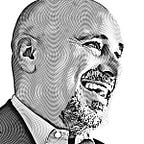FINDING THE FUNNY. (5 Ways to Leverage Humor in TED Talks.)
Today, let’s dive into five dimensions of humor in TED Talks.
After all, chuckles matter. Even TED Head Chris Anderson emphasizes the importance of humor in a talk. In his bestseller, TED Talks, he writes:
“Audiences who laugh with you quickly come to like you. And if people like you, they’re much readier to take seriously what you have to say. Laughter blows open someone’s defenses…”
Successful TED Talk speakers — about 60% of the top 100 — make generous use of humor. And laughter is particularly concentrated in the top 10 talks, where all 10 leverage chuckles. (Even Bill Gates’ talk about the Ebola virus breakout offers up one joke.)
Humor is a power tool for connection. Researchers examining talks have found that “just hearing clips of laughter can activate key regions in your brain, triggering you to smile or laugh yourself. And, when participants in one study watched a funny video, they laughed significantly longer and more often when another person was present — even though they reported feeling the same level of amusement.”
For comparison and study,
explore the following 5 top TED Talks for best practices related to humor. A key principle will be illustrated in each.
1. REALLY, TRULY AVOID IT.
Seriously. If you’re not gifted with a funny bone, don’t try. Humor doesn’t come naturally to most of us and it demands a lot of work to pull off. Instead, focus on what you do best and use other engaging techniques to connect with your audience. Consider pivoting to uber-engaging approaches like STICKY Stories and leave the comedy routine to comedians!
→ Watch #5 Top TEDsterSimon Sinek serve up a flat joke at the 10:14 minute mark (e.g., only 2–3 people respond) in How great leaders inspire action. Also note that the talk tallies only 3 additional laughs in total.
2. WORK REALLY, REALLY HARD.
See rule #1. Now, if you’re determined to get your audience chuckling, know it can be a heavy lift — even for professionals like Jerry Seinfeld. In fact, it is worth noting that the best standup comedians perfect their acts on small, amateur stages for months before a high-stakes audience. So put in the reps; it will pay off!
→ Watch #2 Top TEDsterTim Urban get his audience laughing within 13 seconds in Inside the mind of a master procrastinator and keep going — setting the record for the most laughter in a top talk (35 times or approx. every 24 seconds). Also note his blog post about talk prep and humor.
3. HUMOR ISN’T COMEDY.
While both humor and comedy aim to elicit laughter, they serve different purposes. Humor is the use of wit or clever observations. TED Talks are generally built around serious topics, so avoid the physicality of the Three Stooges. Similarly, dry jokes are caught by the few. So opt for chuckles rather than graffaws!
→ Watch #26 Top TEDsterShawn Achor score his first laugh at the 00:11 minute mark in The happy secret to better work. From that point, he continues to drop quips and asides until bringing down the house with a broken arm joke at the 01:20 minute mark.
4. SET A HUMOR BUFFET.
Sometimes, the best humor arises spontaneously from the situation. So be open to jumping on an unexpected wave and riding it for a few more cycles. Have a “humor buffet” of optional jokes at the ready. In your delivery, pay close attention to your audience’s nonverbal cues and reactions. Adjust your flow based on their engagement levels!
→ Watch #1 Top TEDster Sir Ken Robinson drop his second joke at the 01:10 minute mark in Do schools kill creativity? He then returns to the buffet 4 times to keeps laughter bubbling.
5. USE HUMOR HITS.
Self-deprecating jokes and observational humor are winning hits. So gently poke fun at yourself. It makes you more relatable and can help to put folks at ease. For example, share a funny personal mishap or an awkward moment. Keep an audience engaged by tapping into the shared goofiness of life!
→ Watch #4 Top TEDsterBrené Brown open with a self-deprecating story at the 00:16 minute mark in The power of vulnerability. She brings down the house.
Done right, humor can deeply engage your audience and make your message more memorable.
As communications expert and author of Talk Like TED, Carmine Gallo writes:
“Incorporating humor into your presentations is not just about getting laughs; it’s about creating an emotional connection with your audience, making your message memorable, and keeping them engaged throughout your talk.”
So the next time you’re prepping for a talk, don’t underestimate the power of a well-placed (and well-practiced) laugh.
And remember, if they’re laughing, they’re paying attention!
DEVIN D. MARKS is known as The TED Talk Whisperer. His firm, CONNECT to COMPEL, has served 100s of TED, TEDx, and TED-Style speakers. The result: 100s of millions of views. His team help niche experts, authors, and leaders just like you, spread BIG ideas.
Let the world LIVE your message!™
You can reach Devin at 617.804.6020, or DM him here.
